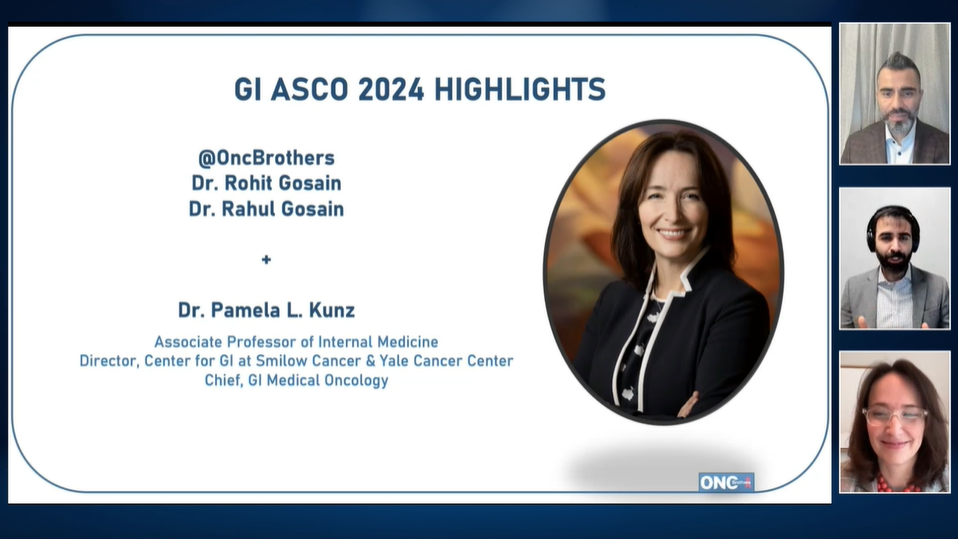Morse Gives an Overview of Treatment Options in Colorectal Cancer Case Studies
Michael Morse, MD, discusses treatment considerations and options for 2 cases of patients with colorectal cancer
Michael Morse, MD

Michael Morse, MD
Michael Morse, MD, recently sat down withTargeted Oncologyto discuss treatment considerations and options for 2 cases of patients with colorectal cancer. Morse, professor of medicine, Department of Surgery, Duke Cancer Institute, discussed these cases during a live case-based peer perspective event.
Case 1
In the first case, the patient was a 70-year-old female who presented with bloody stool. Her medical history included type 2 diabetes. She had no other comorbidities.
A colonoscopy revealed a 1.5 cm tumor in the sigmoid colon. A biopsy of the sigmoid colon mass showed moderately differentiated adenocarcinoma,KRAS,NRAS,BRAFwild-type and microsatellite stable (MSS) disease. A CT scan revealed 3 hepatic lesions, the largest was 4 cm abutting the portal vein. Her ECOG performance status score at the time was a 0.
TARGETED ONCOLOGY:How would you manage the patient at this point?
Morse:
We would review this woman’s case in a multidisciplinary environment including a consultation with surgical oncology to determine whether her hepatic metastases are resectable, borderline resectable, or unresectable. We would also confirm that there is no indication (imminent risk of obstruction, perforation or significant bleeding) for resecting the primary tumor at this time.
TARGETED ONCOLOGY:What treatment would you initiate?
Morse:
The liver metastases were deemed borderline/potentially resectable and it was recommended to administer systemic therapy with an attempt to convert the metastases to resectable. FOLFIRI, FOLFOX, or CAPEOX with or without bevacizumab (Avastin); FOLFIRI or FOLFOX with or without panitumumab (Vectibix); or cetuximab (Erbitux) or FOLFOXIRI with or without bevacizumab are all options for patients with unresectable synchronous liver metastases. We would evaluate for conversion to resectability with imaging studies every 2 months. We would discuss the possible toxicities with the patient to understand which would have special concern for them. For example, she is a diabetic and if she had baseline neuropathy, then oxaliplatin (Eloxatin) may carry additional concern.
TARGETED ONCOLOGY:Would your treatment choice be different if the tumor was in the cecum?
Morse:
Recent retrospective analyses of several major first line studies of the treatment of metastatic colon cancers have demonstrated that among patients withKRASwild-type cancers, those with left-sided cancer had improved progression-fres survival (PFS) and overall survival (OS) from the addition of cetuximab to chemotherapy while those with right-sided tumors did not; however, right-sided tumors do have PFS and OS benefit for the addition of bevacizumab to chemotherapy. Therefore, a bevacizumab-containing regimen would be preferred for right-sided tumors.
TARGETED ONCOLOGY:If the patient’s tumor wasBRAF-mutated, would that have changed your plan?
Morse:
OncogenicBRAFmutations (mostly V600E) are associated with poor prognosis. Further, data from numerous studies in aggregate suggest that there is limited activity for anti-EGFR therapy in metastaticBRAF-mutant colorectal tumors. Based on the observation of a similar treatment effect, regardless ofBRAFstatus, for FOLFOXIRI plus bevacizumab compared with FOLFIRI plus bevacizumab, it has been suggested that FOLFOXIRI plus bevacizumab is a potential option for the first-line treatment ofBRAF-mutant mCRC patients. Of course, the toxicities are greater for this combination, which may only be appropriate for an older patient if they have an excellent performance status.
TARGETED ONCOLOGY:Would you consider a locoregional therapy to the liver?
Morse:
In the past, locoregional therapy has been reserved for palliative control of refractory, liver-predominant colorectal cancer; however, the SIRFLOX trial randomized patients with previously untreated metastatic colorectal cancer with or without limited extrahepatic metastases to the addition of selective internal radiation therapy (SIRT) using yttrium-90 resin microspheres to FOLFOX-based chemotherapy. Although adding SIRT did not improve PFS at any site, it did delay disease progression in the liver. Data from this and 2 similar studies will be pooled to assess OS.
TARGETED ONCOLOGY:FOLFIRI plus cetuximab was initiated for this patient with the usual moderate rash noted, which was controlled with topical moisturizers and minocycline, and she remained on therapy until progression at 11 months. How would you manage the patient now?
Morse:
In the past, locoregional therapy has been reserved for palliative control of refractory, liver-predominant colorectal cancer; however, the SIRFLOX trial randomized patients with previously untreated metastatic colorectal cancer with or without limited extrahepatic metastases to the addition of selective internal radiation therapy (SIRT) using yttrium-90 resin microspheres to FOLFOX-based chemotherapy. Although adding SIRT did not improve PFS at any site, it did delay disease progression in the liver. Data from this and 2 similar studies will be pooled to assess OS.
TARGETED ONCOLOGY:She was given FOLFOX plus bevacizumab for 8 cycles, at which time the oxaliplatin was discontinued to avoid neuropathy. 5-FU/bevacizumab/leucovorin was continued for 5 more cycles. With CT imaging, it was shown that she developed progression in the liver and lung. Her ECOG performance status score is now a 1. How would you manage the patient now?
Morse:
Trifluridine plus tipiracil (TAS-102; Lonsurf) or regorafenib (Stivarga) are indicated for patients who have previously received therapy with fluoropyrimidines, irinotecan, oxaliplatin, an anti-VEGF biologic therapy, and, ifRASwild type, an EGFR targeted therapy. It is important to point out that the studies leading to the FDA approval of these 2 drugs enrolled patients with an ECOG performance status of 0 or 1, as is the case for this patient.
TARGETED ONCOLOGY:In which patients would you consider regorafenib, and for whom would you consider prescribing trifluridine and tipiracil?
Morse:
Because each of these drugs was tested against placebo in separate studies, we cannot directly determine which would be preferred. In the CORRECT trial, regorafenib improved OS with a median survival time of 6.4 months versus 5.0 months (HR 0.77). In the RECOURSE trial, trifluridine/tipiracil improved OS from 5.3 months with placebo to 7.1 months (HR, 0.68). The most common clinically relevant side effect with trifluridine/tipiracil is neutropenia, including febrile neutropenia, and low grade nausea, vomiting and diarrhea can occur. Whereas for regorafenib, common clinically relevant side effects were asthenia/fatigue, decreased appetite and food intake, hand-foot skin reaction, diarrhea, mucositis, elevated transaminases, weight loss, hypertension and dysphonia. This difference in toxicities may guide agent choice. For example, a patient with severely compromised marrow function may be a better candidate for regorafenib while a patient wishing to avoid hand-foot skin reaction may choose trifluridine/tipiracil.
Case 2
In the second case, the patient was a 57-year-old male who presented for a routine colonoscopy and was found to have an ascending colon moderately differentiated adenocarcinoma. His CEA pre-operatively was a 6.
A laparoscopic colectomy with colo-colonic anastomosis was performed. Final pathology showed a T3N0 lesion. 0/17 lymph nodes involved. There was lymphovascular but no perineural invasion (high-risk stage IIa).
TARGETED ONCOLOGY:What is the likelihood of disease recurrence in a patient who is stage IIa after resection and how does it differ from stage IIIa?
Morse:
This is a case of stage IIa with a high-risk feature (lymphovascular invasion). Although it is generally observed that the 5-year disease free survival rate is about 83% for stage II, the number of risk factors (such as few sampled lymph nodes, vascular invasion, perineural invasion, obstruction) affects the outcome. Stage IIa (T3N0) patients with no risk factors have a recurrence risk at 5 years of as low as 10% , 15% for 1 factor, and >20% for multiple risk factors. Stage IIIa/b has been quoted to have recurrence risks of 21% to 38% with chemotherapy. There are several calculators that can be used to estimate the risk of recurrence, includingwww.nomograms.org(from Memorial Sloan Kettering) and Numeracy (Mayo Clinic).
TARGETED ONCOLOGY:How would you manage the patient now?
Morse:
Options for treating a patient with T3N0M0 at a high risk of systemic recurrence include capecitabine or fluorouracil plus leucovorin or FOLFOX or CAPEOX or FLOX; however, it should be noted that a survival benefit has not been demonstrated for the addition of oxaliplatin to fluorouracil and leucovorin in stage II colon cancer.
TARGETED ONCOLOGY:Six months after completion of adjuvant therapy, CT scans showed multiple hepatic nodules. Upon testing,KRASmutation,BRAFandNRASwild-type, and MSS are discovered. How would you manage the patient at this point?
Morse:
This patient was deemed to have unresectable liver metastases. FOLFIRI with or without bevacizumab or ziv-aflibercept or ramucirumab (Cyramza) are the standard options. Due to the recent progression after FOLFOX adjuvant therapy, FOLFOX- or CAPEOX-containing regimens would not be preferred. Because of theKRASmutation, EGFR targeted therapy is not indicated.
TARGETED ONCOLOGY:The patient was started on FOLFIRI plus bevacizumab. The patient again needed a dose reduction due to significant mucositis and diarrhea, but was able to receive 12 months of reduced-dose FOLFIRI plus bevacizumab. At that time, there was progression of the hepatic metastases. What would you consider now for this patient?
Morse:
The patient has now progressed after FOLFOX adjuvant therapy and FOLFIRI plus bevacizumab, and is not a candidate for EGFR-targeted therapy; therefore, the standard options are trifluridine/tipiracil or regorafenib.
TARGETED ONCOLOGY:Assuming you prescribed trifluridine/tipiracil, what monitoring would you do?
Morse:









